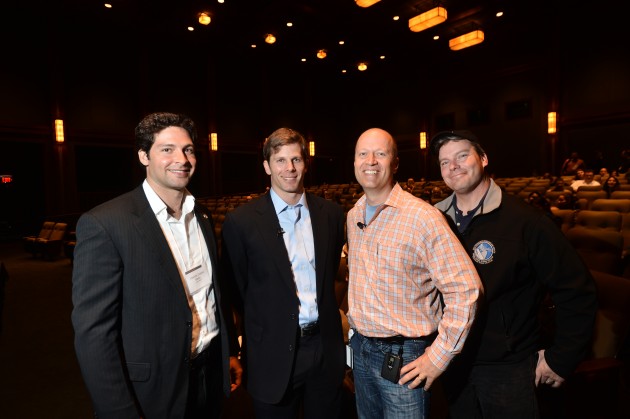Autodesk is a company which many are familiar with. They are widely known for their multitude of applications that deliver the best of the best in the entertainment industry. Animation, visual effects, virtual production, motion capture, and everything in between is typically fueled by a piece of software from Autodesk. With so much pomp and circumstance around their film industry successes, it’s easy to forget that the company offers industry-changing software solutions for other markets. Last week I was invited to Lucasfilm in San Francisco to hear first hand about how those very products are fueling Academy Award winning films and visual effects, but perhaps more importantly to hear about how the many products in Autodesk’s massive catalog of software are delivering life-changing results that have nothing to do with the silver screen.
Within the plush confines of the second greatest movie theater in the world—nestled deep within Lucasfilm’s facility in San Francisco (second only to the one at Skywalker Ranch)—I listened to three Autodesk users tell of their success in their respective industries with the various solutions in Autodesk’s arsenal. Presenting was Dave Story, CTO of Lucasfilm, Ian McKee, founder of EcoArenas, LLC, and Bart Ney, senior communications manager of Caltrans. Each had very different problems and challenges, and each found impressive solutions with Autodesk software.

From left to right: Vicente Castro Mello, Ian McKee, Dave Story, and Bart Ney (Photo courtesy of Noah Berger)
Dave Story opened up his presentation with an explosive reel of work by Lucasfilm Animation and Industrial Light and Magic. ILM is one of the oldest and most successful visual effects houses in the world. They have a history of academy awards in the VFX department, including nominations and wins for the last 16 consecutive years. ILM are responsible for many major milestones in computer graphics, such as bringing Photoshop into the world, creating the first ever fully computer generated film sequence, and nurturing Pixar into existence. Their impact on the film world is legendary, and their current work reflects the best of the best.
Today, ILM operates a PC Linux environment and relies of many of Autodesk’s entertainment suites of software. Maya, Motionbuilder, and Mudbox feature prominent roles in their production pipeline. Dave explained that ILM have a very close relationship with Autodesk, sharing much of their research and experience with the company to help improve their software. Dave attributes much of their success and capability to the power of the entertainment suites from Autodesk. In fact, Lucasfilm Animation’s first feature-length animated film, Rango, was nominated for and won the best animated feature Oscar, beating industry giant Dreamworks Animation (Pixar was not nominated in 2011). Dave said, with beaming pride, that this feat couldn’t have been accomplished without the tools they used from Autodesk.
Autodesk in the arena
Ian McKee followed up Dave’s presentation and completely changed gears. Ian is a Sustainability and Green Building consultant who founded EcoArenas, LLC. EcoArenas, a consulting firm that specializes in green building designs, teamed up with Castro Mello Arquitetos to tackle a massive project. As the designer for the Estádio Nacional de Brasília, Ian’s team have undertaken the monumental effort of creating a new, state-of-the-art soccer stadium in Brazil that will not only host the 2014 World Cup, but will also be the first LEED Platinum certified stadium, giving the stadium an incredibly low carbon footprint.
Ian was born in Brazil, and like most of his countrymen, he has a true passion for fútbol. He started his presentation by showing photographs of the current state of Brazil’s stadium in Brasilia. Ian progressed through images that showed neglected facilities and unacceptable conditions. Entire grandstand areas are nothing but concrete slabs to sit upon (or in the case of football, stand upon). Some seats offer no more than a view of the goal area, as 90% of the pitch is blocked from view by giant, poorly placed concrete support pillars. Bathrooms lack proper privacy and hygienic equipment. A disease-ridden moat of standing water surrounds the pitch. One photograph showed a flooded grandstand due to lack of drainage with water deep enough for fans to swim in. It was tragic to see these images of a country that loves football, but cannot provide a modern facility for its fans. As Ian explained, the fans tolerate the state of the stadium with a saying in Portuguese that loosely translates to “It’s just the way things are in Brazil.”
EcoArenas set out to not only design a modern, proper stadium for Brazil, but to also make it a high-efficiency green building. Using Autodesk’s AutoCAD, Ian’s team designed a bold new stadium that accomplished all of their green initiative challenges while being fully functional and fitting in to the local design aesthetics of Brasilia. The Estádio Nacional de Brasília is adorned with solar panels across the majority of the roof, able to generate enough power for full operation. The stadium is designed to have a minimal carbon impact during peak usages (such as games), while becoming essentially nonexistent when not in use. The roof is even designed to funnel rainwater to be used in various methods of building sustainability. The entire stadium is a fascinating piece of modern architecture.
Ian credits Autodesk’s software with providing his team the tools to create this masterpiece of green building technologies, as well as giving them the ability to pitch the design to the local government in photorealistic detail. Most importantly, Autodesk’s design and engineering software gave EcoArenas, a group quite small in comparison to major firms, an opportunity to make a massive impact in an industry that is held in high importance to all Brazilians.
Autodesk on the road
Finally, Bart Ney took the stage to show us how Caltrans’ use of Autodesk software is affecting development of my home, the Bay Area of northern California. The Oakland Bay Bridge is a sort of little brother to the world-renowned Golden Gate Bridge. The Bay Bridge is a pair of bridges connecting San Francisco to the city of Oakland, running east to west. As the primary connection between these two cities, the Bay Bridge serves in excess of 270,000 cars every day. Like the Golden Gate, the Bay Bridge is an essential component of daily business in both San Francisco and Oakland, and any disruption to service on the bridge results in traffic jams of untold magnitude.
Caltrans has been tasked with rebuilding the eastern span of the Bay Bridge with a more modern, earthquake-proof design. The eastern span has been under local criticism since 1989 when the 6.9 magnitude Loma Prieta earthquake caused a section of the bridge to collapse. An estimated 6.3 billion dollars have been spent on the redesign, which is planned to open to the public just after Labor Day 2013.
Bart explained how Caltrans knew the thought of closing the Bay Bridge was absolutely terrifying for everyone that lives and works in the area, and they knew that they would have to convince everyone that what was being done to the bridge was not only necessary, but completely possible. The new eastern span bridge, designed with Autodesk software, has been constructed alongside the current eastern span. Caltrans was able to simulate the entire construction process of the new eastern span before ever laying a piece of physical steel on site. Bart explained that this helped save costs on the project, as well as identify potential construction issues before they become costly mistakes.
A closure of the bridge is obviously necessary to connect the current bridge to the new span. Rather than letting the public remain in the dark on the plans of the bridge, Caltrans set out to meticulously recreate the entire process using Autodesk software to show the public exactly what needs to be done, and on what timeline the work will take place.
Bart showed us the animated sequences created for the project. In full 3D with photorealistic visuals, the current bridge and new bridge are clearly displayed, and as the animation plays out, every step of the bridge replacement and connection to the new Eastern span is detailed over the course of a couple of high-speed days. Caltrans provided this footage to local news affiliates to help the commuters understand exactly what needs to be done, why it is important to make these changes, and help prepare for the small downtime required for the construction.
The entire effort on the new Eastern span has been monumental, but perhaps the greatest achievement of Caltrans was the fact that they were able to assure the public that this replacement would be mostly painless, and to calm the ire of concerned commuters. Pre-visualization made possible by Autodesk has helped Caltrans in ways previously not possible.
I expected to leave Lucasfilm with my head spinning of thoughts of visual effects and animation. While I certainly enjoyed the exposure to the mind-blowing entertainment accomplishments of one of the finest VFX houses in the world, I also left impressed at the sheer scale of which Autodesk and its products have managed to touch the world. From improving the quality of life of soccer fans in Brazil, to preventing future tragedy in my corner of the world, Autodesk’s many pieces of software serve a much higher purpose than just keeping us entertained at the movies. Our world is made better by the work brilliant people are doing with these tools.











 Articles RSS
Articles RSS